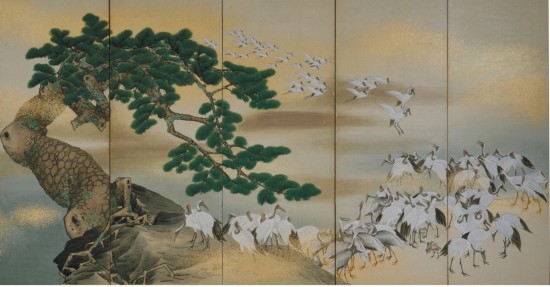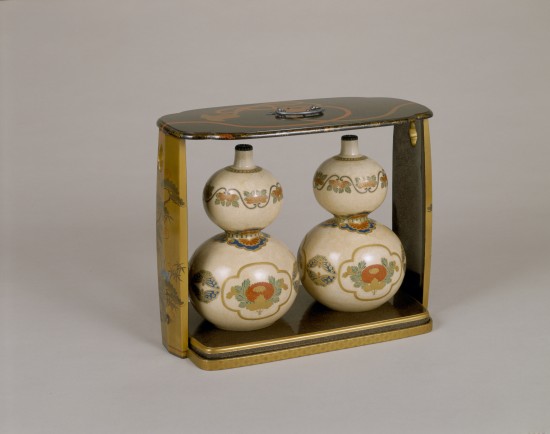From the Kankai Pavilion at Hara Museum ARC, Gunma
In East Asia, auspicious notions such as longevity, fertility and wealth, have long been expressed by a great variety of symbols such as the crane, tortoise, pine, bamboo, plum, peony and sacred wish-granting jewel. To mark the arrival of the New Year season, this exhibition presents art and crafts featuring subject matter or designs that are expressions of these auspicious notions, in forms representing beliefs and customs from ages past.

Mori Tetsuzan, A hundred cranes (left screen), Edo period
–A coastline stretches gently from a large pine tree with roots deeply embedded into the rock cliff. Flying from the sky down to the shore are red-crowned and white-naped cranes in various poses. Because of the beauty of their appearance and voice, the crane in China is regarded as a sacred bird. In Japan, it is said that the crane lives for a thousand years, and the turtle ten thousand years, making them symbols of perpetual youth and longevity. The pine, as an evergreen, has the same connotation. All of these symbols together make this a very auspicious painting.

Pair of Satsuma ware sake bottles with portable maki-e case, Edo period
–Shape of the frame is taken after a toy in form of an octagonal column with two wheels called “buri buri” that children in the Edo period played with in the New Year. From the middle of the Edo period, “buri buri” was used as a talisman, to be displayed inside of a house at the beginning of a new year, or as a gift, such as wishing for the healthy growth of children. The auspicious pine-bamboo-plum motif and the crane & turtle motif are also painted on the sides.
During the New Year season, it is customary among Japanese to decorate alcoves with paintings and crafts with auspicious symbolism and to exchange wishes for health and good fortune in the coming year. In this spirit, we invite you to come view these works at the Kankai Pavilion as a wish for good tidings in the New Year. Selected works of contemporary art will also share the space for greater viewing pleasure.
【Featured works】
Traditional Art: Kano School, Landscape with snowy mountains (originally part of works painted on wall paper and sliding doors at Nikko-in Mi’idera temple), four hanging scrolls, Momoyama-Edo period/ Mori Tetsuzan, A hundred cranes, pair of six-fold screens, Edo period / Yokoyama Taikan, Seaside landscape with sunrise, hanging scroll, Meiji period/ Pair of Satsuma ware sake bottles with portable maki-e case, Edo period/ Boxed set of utensils used in incense guessing game decorated with pine, bamboo and plum motifs, Edo period/ Lacquered monk’s staff (“Ruyi”) engraved with auspicious motifs, Qing dynasty and others
Contemporary Art: Shusaku Arakawa, Look at It No.3, 1968/ Claes Oldenburg, Soft Screw, 1976/ Nam June Paik, Candle TV, 1980/ Anish Kapoor, Void, 1992/ Daisuke Nakayama, grape rain, 2003 and others
—————————————-
Hara Museum ARC winter exhibitions
◆Kankai Pavilion
“Celebrating the Auspicious”
◆Contemporary Art Galleries
“Cheer up! Art can make you happy—Selections from the Hara Museum Collection”
Dates: December 18 (Sat.), 2010-January 4 (Tues.), 2011
Closed: January 1 (Sat.), 2011
*The museum may also be closed in the event of severe weather.
<Hara Museum website>http://www.haramuseum.or.jp
<Hara Museum mobile site>http://mobile.haramuseum.or.jp
